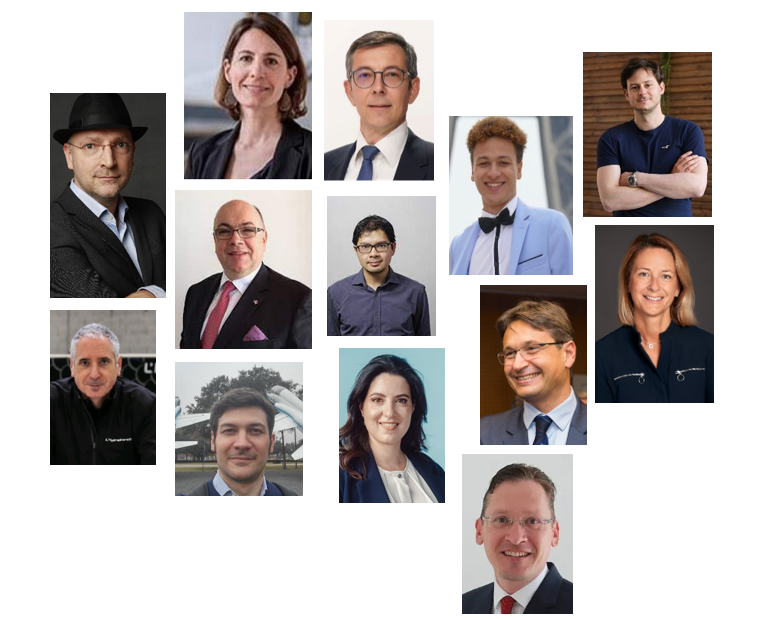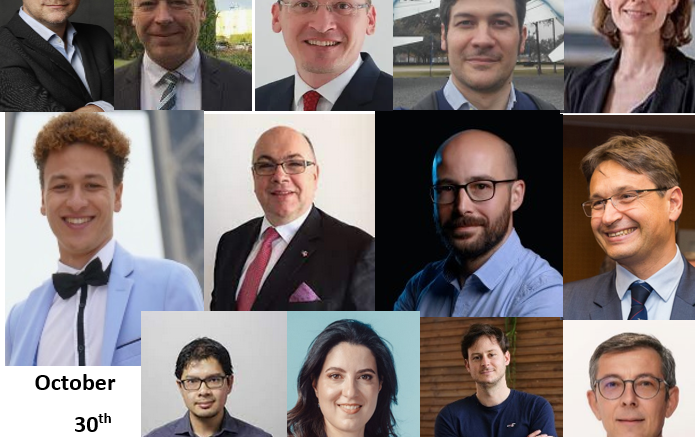
PETER SCHMOLLGRUBER, ONERA
2.30 – 3.30 PM
 Peter Schmollgruber ONERA | Peter Schmollgruber started his professional career as Wind Tunnel Test Engineer for the Ferrari Formula 1 team in 2000. In 2002, he decided to work as Graduate Research Assistant at the Aerospace Systems Design Lab of the Georgia Institute of Technology where he graduated with a Master of Science. In 2004, he joined Leonardo to follow the development and flight tests of the UAV Falco. Since 2006, he has been working for ONERA in the field of Aircraft Design. In 2016, he took the lead for the Scaled Flight Testing project within the European Program Clean Sky 2. In 2018, he received his Ph.D. in Aircraft Design from ISAE-SUPAERO. Since 2019, he is Program Director for Civil Transport Aircraft within the ONERA Program Directorate. Peter will present ONERA research activities towards decarbonizing aviation. The presentation focuses on the various activities performed within the ONERA scientific departments in order to converge towards an ultra-efficient aircraft. The studies cover improvements of aerodynamics efficiency, aircraft weight reduction and propulsive efficiency increase. In addition, details about future configuration explorations are provided. Last, advanced testing capabilities supporting the development of future aircraft are presented |
NICOLAS BONLEUX, COBHAM AEROSPACE COMMUNICATIONS
6 -7 PM
 Nicolas Bonleux Cobham Aerospace Communications | Nicolas Bonleux joined Cobham Aerospace Communications as CEO in June 2022. Nicolas holds a degree from HEC Paris School of Management (Paris, France) and has a rich career in the aerospace industry. He has worked for Thales as Business Development Manager and Liebherr-Aerospace & Transportation, where he held several business development and executive management positions before becoming Managing Director and Chief Commercial Officer. THE REVOLUTION IN ON-BOARD AIRCRAFT CONNECTIVITY The connectivity on-board the aircraft is undergoing a revolution. The progresses in connectivity technologies – compactness, reliability, cybersecurity, quality of data- allow substantial enhancements in the communications between the aircraft and its environment –air traffic control, airport, other aircraft, airline operations. This development will enable augmented capabilities that will contribute to optimizing the trajectories, optimizing the aircraft drag and maneuverability, optimizing the pilot workload and optimizing the safety and the quality of the exchanges between the pilot and his environment. This development is based on : 1. Smaller or integrated antennas 2. Next generation audio/radio management systems 3. next generation satellite communication (satcom) systems (note : this point is subject to a specific presentation – see below) |
PEDRO BAUER, UNIVERSITY OF MUNICH
4.50 – 5.50 PM
 Pedro Bauer Munich University of applied sciences | Pedro Bauer is student at Munich University of applied sciences. He’s currently studying aeronautical engineering in 7th semester, where he is part of the universities flight-simulator department. He is writing his bachelor-thesis at the company iwiation GmbH about a warning concept for runway incursions at small aerodromes. Presentation Title: Generating a cockpit-warning for a runway incursion at small aerodromes with the help of artificial intelligence. |
PASCAL PARANT, AAA Corp
3.40 -4.40 PM
 Pascal Parant AAA Corp. Pascal Parant AAA Corp. | Pascal Parant currently serves as Vice President, Marketing of AAR CORP. Mr. Parant joined the company in 1999 and has held several positions in different divisions that have given him a global view of the company. He became Vice President, Marketing in January 2007. In this role, Mr. Parant is building long-term relationships with existing clients and attracting new airline and OEM customers. In addition, he acts as a liaison between different AAR business units, increasing the flow of timely information across international locations and with customers. Mr. Parant is a graduate of ESTACA (92), a French Aeronautical Engineering School. Mr. Parant has been a board member of Air Mediterranee, a French Charter Airlines, from 1997 till 2016. |
BRUNO FERRAN, ASCENDANCE FLIGHT TECHNOLOGIES
 Bruno Ferran Ascendance Flight Technologies | Ascendance Flight Technology, Bruno Ferran “Entrepreneur and aeronautical engineer, he focus his work on the development of more sustainable aeronautical technologies. A graduate from ISAE-SUPAERO, he has 10 years of experience in electric and hybrid aviation where he took part in 2 of the very first all electric aircraft in the world in a Brazilian SME and at Airbus working on the E-FAN program. Entrepreneur and aeronautical engineer, he focuses his work on the development of more sustainable aeronautical technologies. A graduate from ISAE-SUPAERO, he has worked for the past 12 years in electric and hybrid aviation where he took part in two of the very first all electric aircrafts in the world in a Brazilian SME and at Airbus working on the E-FAN program. Co-inventor of 10 patents, he then co-founded Ascendance Flight Technologies in 2018 with 3 other former members of the E-FAN team to develop ATEA: a VTOL hybrid aircraft as a more sustainable alternative to helicopters as well as STERNA, its hybrid propulsion chain, which will be offered to other aircraft manufacturers to support the decarbonisation of the entire aviation industry. |
CHARLOTTE VOISIN, TOULOUSE METROPOLE
6 to 7 PM

| Charlotte Voisin, Economic Development & Inward Advisor – Aeronautic & Space, is the aeronautics, space & drone manager at Invest in Toulouse, the economic development department of the Toulouse Métropole promotion agency. With her MBA and her experience in this industry, she is in charge of identifying, supporting and advising innovative companies from the exploration to their establishment in the Toulouse ecosystem. She promotes the pink city and tries to find new gems willing to open offices and create jobs there. Title of her presentation: The current and future H2 infrastructure planned by Toulouse, as well as the interactions in the aerospace industry |
KARINO KANG, LEVIATHAN DYNAMICS
2.30 -3.30 PM
 Karino Kang Leviathan Dynamics Karino Kang Leviathan Dynamics | Karino Kang is the founder and CEO of Leviathan Dynamics, a startup that develops and produces more efficient and ecological solutions for heating and cooling processes. He is an engineer in mechanics with a specialty in fluid mechanics and energetics. He has 8 years of experience in the industry, working as a project manager for an energy company. He met Alan Chauvin, his co-founder and CTO, in 2016 and they decided to create Leviathan Dynamics to offer an alternative refrigeration system that does not use polluting fluorinated gases. His subject: Decarbonation of spaceport cooling production and hygrometric control Cooling production represents 2/3 of the electricity consumption of the French Guyana Space Center. In addition, the main refrigerant used on the space port is R134A which is a potent greenhouse gas. Each year, the mass of R134A used for refilling the refrigerant tank can be counted in tons. With a GWP of 1500, the GHG emissions due to leakage of HFC refrigerant can be counted in thousand of tons. In a context of global warming, mastering GHG emissions due to cooling equipment is key for the sustainability of the operation of the Space Port. Leviathan Dynamics has installed a first pilot of a chiller that is using only water as refrigerant, allowing the complete phase-out of HFC refrigerant and also potentially reducing energy consumption by 30%. |
MARCUS BAUER, IWIATION
4.50 -5.50 PM
 Marcus Bauer Iwiation Marcus Bauer Iwiation | Dr. Marcus Bauer received his Bachelor in Aeronautics, his Master of Science in Mechanical Engineering and his Ph.D. from the Institute of Flight Controls and Flight Mechanics from Darmstadt University in Germany. Within his doctoral thesis he developed the world-wide unique iwi® methodology to reconstruct flight data based on visual footage. He has an extensive aerospace experience due to his work at Lufthansa-Flight-Training, different positions within in the Airbus Group and Siemens AG for electrical flight propulsion systems. His presentation: Improving Aviation Safety with lessons learned: Safety is number one priority in aviation. Global statistics shows that safety in aviation is overall continuously improving. However human factors is one of the main reasons for today’s incidents or accidents. The investigations focus on root cause analysis with safety recommendation to be executed to avoid similar incident or accident. This provides a look inside the possibilities how communication on lessons learned factors, especially on human factors can be done, to further improve aviation safety. |
CHRISTOPHE ROBIN, DAHER
6 -7 PM
 Christophe Robin Christophe Robin Daher | Christophe Robin is the head of design of Daher, a French aircraft manufacturer that is part of the EcoPulse project. He is responsible for the installation of the components and systems, the flight tests, the global analysis and the regulatory approach of the EcoPulse demonstrator, which is a hybrid-electric aircraft with distributed propulsion. He joines Daher in 2011, after being the founder and CEO of Dyn’Aero, a company that produced light aircraft such as the CR100 and the MCR-4S . He has a background in engineering and aerodynamics, and is passionate about innovation and sustainability in aviation. He is one of the key players in the development of EcoPulse, which aims to reduce the environmental impact of aircraft and create new uses of air transport. His presentation: Making a hybrid aircraft is not the same as hybridising an aircraft At a time when the aeronautics industry is joining forces to meet environmental challenges, many debates are focusing on aircraft configuration and propulsion technologies, which are merely means to an end. With the objective of decarbonising usage, aircraft manufacturers need to implement solutions to control the entire value chain, beyond the scope of their traditional activities. Upstream, they need to concern themselves with the availability of new (low-carbon) energies, and downstream, with the uses associated with air mobility. Data and digital technologies are at the heart of these issues. Based on the lessons learned from the ECOPULSE hybrid electric technology demonstrator, DAHERcan now project its first product by 2027 to meet all these challenges. |
DAVID GALLEZOT, AVIONS MAUBOUSSIN
6 to 7 PM

David Gallezot is the founder of Avions Mauboussin, a company that manufactures eco-friendly passenger aircraft with hybrid hydrogen propulsion1. He is also an engineer with a degree from École Polytechnique and Supaéro, a mechanic and pilot of light aircraft and gliders2. He is president of Ailes Sud Ouest, an association that transmits ancient aeronautical techniques3.
His presentation title : Blue planes for green territories
Summary: The energy transition is making it possible to offer a comfortable, fast, decentralised, direct, point-to-point means of regional transport with minimal environmental impact: the HSTOL (Hydrogen Short Take-Off and Landing) airplane.
Unlike land-based transport (car, train), which requires heavy, expensive infrastructure (motorways, high-speed lines, etc.) and centralisation (to make them profitable with large flows) , with a heavy impact on both the environment and local residents, the HSTOL airplane can make do with frugal, localised infrastructure: local airfields. Powered by low-carbon hydrogen, silent, it is the ideal vehicle for connecting regions that want to combine attractiveness, economic development and sustainability.
FLORENCE ROBIN, LIMATECH


